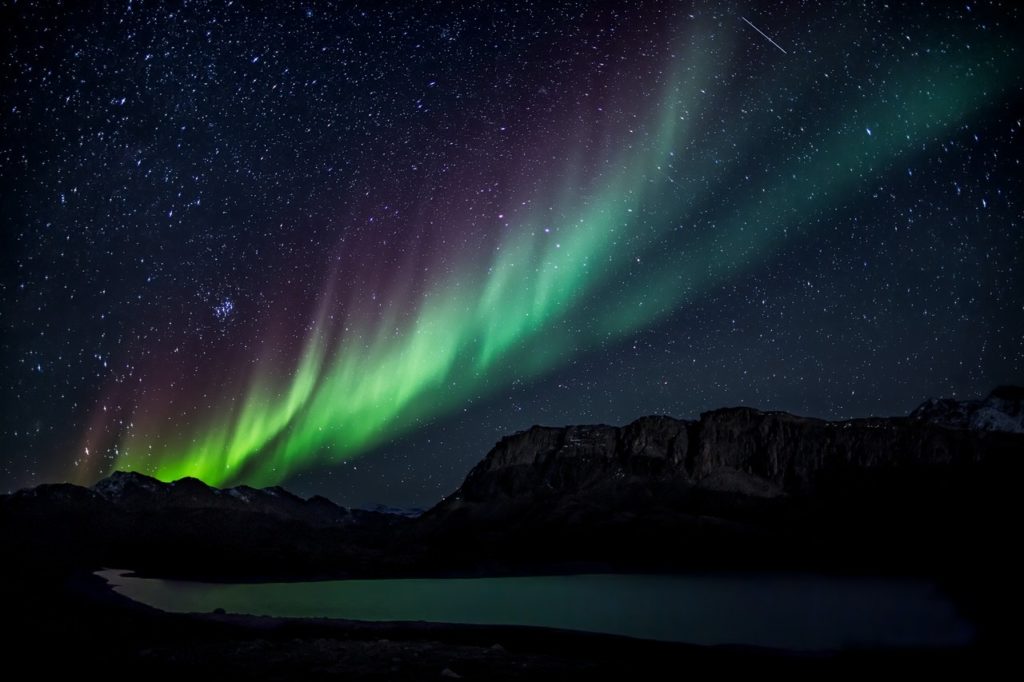
I learned this today. The aurora borealis are green, purple, pink, and blue because those are the colors given off when the different elements in the atmosphere are heated up.
The aurora borealis is caused by electrically charged particles from space hitting the magnetic field in the upper atmosphere at a very high speed.
The sun loses particles all the time and these charged particles race away from the sun at between 400 and 800 km per second. This is known as the solar wind. It is caused because plasma is heated up in the sun’s corona to such a great heat that the sun’s gravity can no longer hold it down. It has so much energy that it escapes out into space and flows through the solar system. It flows well past the end of the solar system and forms a giant bubble that is about 100 times the distance of the Earth to the sun.
The solar wind can harm technology on Earth because it can interfere with satellites and disrupt telecommunications networks. It can even knock out power grids. However, it does far more good for us. It protects us from all of the cosmic rays that come from outside our solar system. These cosmic rays can be dangerous; if we didn’t have the heliosphere, life might not have developed on Earth.
Another thing the heliosphere and the solar wind give us is the aurora borealis. As we orbit round the sun, we sail through the solar wind all of the time. Our magnetic field deflects almost all of the charged particles on into space, but a tiny amount get through. Those that do follow the magnetic field to the north and south poles and on their journey, they interact with the atoms and molecules in the atmosphere.
When the charged particles from the sun collide with atoms in the atmosphere, they excite the atoms by giving them some energy. The atoms slowly decay to their original energy levels and as they do they release the extra energy as light and heat. The heat is carried away by the winds in the upper atmosphere, but the light is what we see as the aurora.
So, why are they different colors? Individual atoms have their own unique electrical states and there is so much energy that they can absorb. All of the same atom have the same property. So, all helium atoms have can absorb the same amount of energy. When atoms are excited, they give off different amounts of energy as light. This energy causes different wavelengths of light, and we know that we see different wavelengths as colors.
Our atmosphere is made up mostly of oxygen and nitrogen. It is about 78 percent nitrogen and 21 percent oxygen. These atoms require different amounts of energy to be excited. Oxygen gives off light that has a wavelength of 557 nm and 630 nm. We see 557 nm as green and 630 nm as red. The difference is the altitude of the atom. The air in the lower atmosphere is more dense so the oxygen atoms can absorb less energy than the oxygen atoms that are higher up where the air is less dense. This is because it takes oxygen molecules longer to release the energy required for the color red. It takes an oxygen atom 0.7 seconds to release the 557 nm wavelength that is green. It takes up to two minutes for it to release the 630 nm that is red. At lower altitudes, there are more other molecules for the oxygen atom to run into. If it collides with another atom, it releases its energy and never gives off the red color. At higher altitudes, there are fewer atoms and the oxygen molecules have the time they need to give off red light.
Nitrogen requires more energy than oxygen to excite and it gives off light that has a wavelength of between 380 nm and 450 nm. We see these as purple and blue. The reds are usually quite hard for us to see because our eyes are five times more sensitive to green than they are to red. That means we mostly see the greens and some yellows.
The aurora also has different colors at different heights. Generally, it is green from about 100 km above the Earth’s surface to about 150 km, then red from about 200 to 250 km. Hydrogen in the lower atmosphere can also sometimes give a pink layer to the bottom of the aurora.
The aurora stops at about 80 km above the surface of the Earth because the air has become too dense for the atoms to give off their light. There are far too many other molecules to collide with and the oxygen molecules don’t even have the 0.7 seconds they need for green. That is why it appears as though the aurora borealis are cut off at the bottom.
So, the aurora colors are caused by the different amounts of energy oxygen and nitrogen molecules give off when they are struck by the solar wind. And this is what I learned today.
Photo by Visit Greenland: https://www.pexels.com/photo/aurora-borealis-360912/
Sources:
http://www.webexhibits.org/causesofcolor/4D.html
https://www.rmg.co.uk/stories/topics/what-causes-northern-lights-aurora-borealis-explained
https://en.wikipedia.org/wiki/Aurora
https://www.space.com/22215-solar-wind.html
https://sci.esa.int/web/ulysses/-/2576-the-heliosphere
https://www.skyatnightmagazine.com/space-science/what-causes-different-shapes-colours-aurora/

